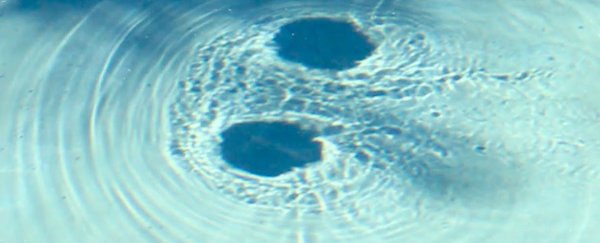In the video above, science vlogger Physics Girl has stumbled across a pretty cool phenomenon. Simply drag a plate through a still pool of water, and you'll see two perfect black circles appear on the bottom of the pool, travelling in unison all the way to the other side without dissipating.
If you look closely, you'll see that these black dots are formed by two vortices that dent the surface of the water. But there's more going on here.
To start with, you need to know a little bit about vortices. A vortex occurs when a gas or liquid moves in circles with what's called a vortex line moving up through those circles - just like in hurricanes and water spouts, like the ones you can see in this rare footage of spouts stretching from the sea to the clouds.
Vortices often form as a result of a difference in fluid speed - like when fast wind moves over slow wind. This is what happens when you drag the plate through the water - the water right next to the plate moves quickly because of friction, but the water further away from the plate is stationary.
As Physics Girl explains, that difference in velocity causes a sheer force that starts the water swirling, and the whole situation is enhanced by the water at the front of the plate being replaced and pushed around its sides, and the water at the back being sucked forward as the plate moves along.
Because a vortex wants to keep its angular momentum, it keeps spinning as it moves through the water, and only loses a little bit of energy through friction with the surrounding stagnant water.
So that explains why the two vortices endure so long without dissipating, but why do they move together perfectly in time?
When we create these vortices, we're forcing water to move around the whole plate, not just at the surface, and this doesn't form two separate vortices, despite what it looks like - they're actually two ends of a curved vortex line. Essentially, we're creating a half vortex ring.
Fascinatingly, you can see the connection between the two vortices if you put some food colouring in either side - it'll spread between the two and make a very clear half ring in the water.
If that's not mind-blowing enough, it also tells you something very cool about vortex rings, which is that the half ring isn't a wave, because a wave doesn't transfer matter, but the vortex very clearly is doing just that with the food colouring.
So why don't we see half vortex rings forming in other places? Things like smoking rings and bubble rings are vortex rings, but they're always complete. This is because of Helmholtz's law, which states that a vortex line can't start or end in a fluid, so it either wants to close into a loop or end at a boundary - in this case the surface of the water.
Watch the video above to find out how this half vortex ring bends lights and causes those perfect black circles to appear at the bottom of the swimming pool. Trust us, it's fascinating. You'll never look at your swimming pool in the same way again.
Source: Physics Girl
